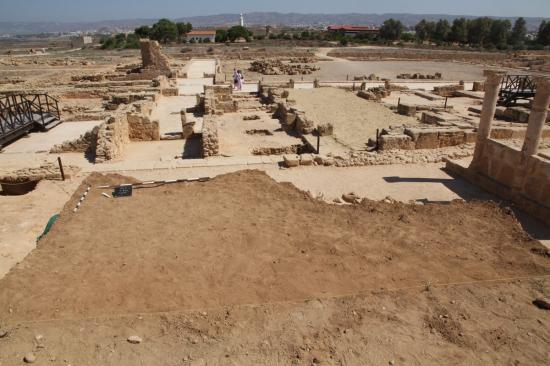Department of Antiquities
Source - http://www.moi.gov.cy/moi/pio/pio.nsf/All/172BE589862FF02AC2257C5C002D8AE2?OpenDocument

The Department of Antiquities, Ministry of Communications and Works, announces the completion of the 2013 excavation season of the Polish Mission at Kato Paphos. Excavation was confined to the remaining southern part of the main courtyard (1) of the so-called Hellenistic House and its southern portico.
Below the surface a layer of soil mixed with stones, sometimes in lenticular concentrations was found as well as indications of stone looting, as already noted in 2011. In some parts however, the original plan of the collapsed constructions could be discerned. It seems that the earthquake, which caused the collapse, was intense and that there existed an upper floor above the courtyard porticoes, the destroyed walls of which constituted most of the rubble layer. These walls seem to have been built in opus africanum / incertum and the position of the pillars, built of larger blocks, seems to be preserved in the arrangement of the rubble. The remains were partly preserved in situ after an earthquake in the second century AD. The stylobate of the southern portico, however, was found to have been robbed out. Its foundation was preserved with traces of gypsum plaster, which was used to set the stylobate blocks. Together with the stylobate, the lowest drums of the southern colonnade had been removed. Between the upper drums of the colonnade remains of entablature were found. These included two acroteria with the symbols of the Dioskouroi: a pilos with a superimposed star. The position of these on top of the entablature is conjectural. Their position could mark the entrance to the building from the south, considering that in the back wall of the portico, which is at the same time the southern elevation of the building on street A', a wide door (2,20 m) was noted. There are also possible traces of its wooden construction left by a set of bronze nails and an iron tube, which may have belonged to the hinge. The portico had a well preserved floor beaten with green clay. The floor of the courtyard itself was found ca 25 cm below the level of the portico floor and the foundation of the stylobate must have been partly visible from the courtyard. The hydraulic floor, remains of which were found in the north-western part of the courtyard in 2011, was well above the original floor of the courtyard, and on the same level with the so-called western stylobate. On its top, traces of the same hydraulic floor are preserved. All traces of walls enclosing the cistem found in 1991, to which this floor belonged, were gone. Attempts to locate it on the southern side of the preserved stretch of floor made it clear that a cut, which separated this stretch from the so-called western stylobate, damaged all traces also on this side, and thus the original extent and function of the hydraulic floor remain unknown. A trial pit was made east of the possible location of one of the Corinthian columns to verify the character of its foundation. The hydraulic plaster covering that part of “stylobate” preserves a partial imprint of a large round base and the base, found at the northern end of the courtyard, was restored. This was topped with a Corinthian capital found at the southern end of the “stylobate”. No foundation of width corresponding to the “stylobate” top course was uncovered and security reasons prevented us from digging deeper under the base.
Along the western side of the well-head of the underground cistern uncovered in 1991, just west of the cistern in the south-eastern corner of this courtyard a settling tank and a pipe starting from street A' were found. The settling tank was built against the reused EW stylobate block (plastered on the western side), repositioned NS and included in a frame of the well-head. The pipe has cut across the southern elevation of the building and cut also the southern stylobate foundation as well as the pipe running along it on the southern side. A fragment of a pipe leading further north from the settling tank was found. It nevertheless may have continued along the foundation supporting the basin, protruding on the west and north below the basin walls. Excavation in the SE part of the courtyard has shown, that the cistern under this part of the courtyard had two, most probably successive well-heads, one uncovered earlier, the other 2.2 m to the NW, the top of which collapsed into the cistern leaving voids in the rubble layer. The latter had a built rectangular shaft, on its eastern side supported by massive blocks, in the direction of the second, later, wellhead. On the other sides of the walls of the shaft, medium-sized, oblong irregular stones were built. The cistern’s floor is covered with large blocks of stone and soil, which has penetrated through the collapsed wellhead; a connection with the wellhead found previously was only partly opened.
In the disturbed fill above the courtyard surface were few small finds of intrinsic interest including 4 coins, 2 well-preserved lamps and a small pawn of dark stone. Among the rubble, numerous decorated architectural members were recorded, including a series of fragments of “Nabatean” capitals of a type first recorded in 2012 which was then described as having schematic volutes, but now, on the basis of better preserved pieces it seems rather that they represent schematic bull-head capitals. This type of “Nabatean” capital occurs only in the main courtyard, but the number of variants known from the entire “Hellenistic House” has risen to five.
Further, two reused blocks belonging to the tholos structure were also been found. Its diameter does not seem to exceed 3 m and it was possibly similar to a tholos in the Arsinoeion in Alexandria. This is obviously only a hypothesis, but it justifies an attempt to verify whether the original tholos did not exist at a lower level under the courtyard of the so-called Hellenistic House.